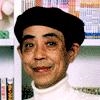 |
| The Doraemon comic book (www.planetadeagostinicomics.com) |
Before I tell you a story about Fujiko F Fujio, I want to tell you a story about how I know Fujiko F. Fujio. I am the youngest member in my family, and I have one older brother. When my brother and I were little children, my parents always bought us books. That's why we enjoy reading very much. Two of our favourite books are Donald Duck series and Doraemon. Donald Duck is Walt Disney's masterpiece, and guess who is the writer of Doraemon? Yup, you're close to that. He is Fujiko F. Fujio, the man I'm going to tell about you in this story.
Fujiko F. Fujio (“¡ŽqEFE•s“ñ—Y) was born on December 1, 1933. His real name is Hiroshi Fujimoto (“¡–{O). In elementary school he met Motoo Abiko (ˆÀ‘·Žq‘f—Y), a transferred student. In junior high school they remained friends, although they went to diferent schools. They were close to each other because they both loved drawing. They also loved almost the same books, such as, Osamu Tezuka'a Shin-Takarajima and Lost World, and Disney's Snow White and the Seven Dwarfs. In high school, Hiroshi and Motoo tried to draw manga (cartoons) and they succesfully made their debut in Tenshi no Tama-chan.
 |
| Fujiko F. Fujio (www.animenewsnetwork.com) |
After graduating from high school in 1952, Hiroshi decided to enter a confectionery company. But quickly he quit the job because of an injury. While he wasn't working, Motoo still worked at a local newspaper publishing company. They found that they still had the interest in drawing manga, so they once again published Utopia: The Last World War (UTOPIA—ÅŒã‚Ì¢ŠE‘åí UTOPIA: Saigo no Sekai Taisen). At this time, their pen name was Ashizuka Fujio. After that they realized that their world was manga. Everything about manga brightened up their lives. So in 1954 they decided to go to Tokyo in order to become cartoon artists (manga-ka).
Hiroshi and Motoo conntinued to draw manga day after day. And they finally changed their pen name to Fujiko Fujio. "A lot of editors of manga publishers visited and asked Fujiko Fujio to write serial manga." They became a popular mangaka. "At the New Year of 1956, they returned home to Toyama. Unfortunately they relaxed so much there that they missed the deadlines of nearly all their manga. They lost their job. After this, they only barely recovered their credibility. In 1959, they left Tokiwa-so, and moved to Usagi-so, and then to Kawasaki, Kanagawa."
In 1962, Hiroshi got married (at age of 28) to Masako. They had three daughters.
"Hiroshi and Motoo established Studio Zero with Shinfichi Suzuki, Shotaro Ishinomori , Jiro Tsunoda , Kiyoichi Tsunoda , and one employee. Later Fujio Akatsuka joined, and finally the studio employed about 80 people. They produced several animated films, for example, Astro Boy. Fujiko Fujio revived their popularity as mangaka again with Qtaro the Ghost in 1964. Both of them continued to write popular manga, for example Hattori the Ninja, Kaibutsu-kun, Pâman, and 21-emon."
In 1970, Hiroshi started writing Doraemon, "after tripping on his young daughter's toy, hearing a neighborhood cat fight, and wishing he had a machine to generate a new manga concept. Between the toy's shape, the cats' yowling, and the longing for a machine to solve his problems, he came up with a robot cat with a pocket containing all sorts of problem-solving gadgets."
 |
| Doraemon and his friends (www.heavenofanime.org) |
"At first, Doraemon did not attract childrenfs attention very much. However, three years later, Doraemon became an animated series on TV, and he became a popular character nationwide. Hiroshi was awarded a prize for Doraemon by Nihon Mangaka Association in 1973."
From 1980 until he died, Hiroshi wrote a series of long manga of Doraemon every year. The manga series were animated on the screen, and every year the animated films were a gold mine for the movie industry. In 1989, Hiroshi won two awards for Doraemon movies (Film Special Meritorious Prize and Golden Gloss Prize).
In 1988, Hiroshi and Motoo ended their partnership, and after that, they worked independently. Another Hiroshi's manga was T.P. Bon.
On September 23, 1996 at age of 62, Hiroshi died of liver failure. Even though he couldn't be with us anymore, people will always remember him as Fujiko F. Fujio, the creator of Doraemon, our beloved cartoon character.
As an honour to Fujiko F. Fujio, The Kawasaki Municipal Government, the Fujiko Production company and the widow of Fujiko F. Fujio, have announced plans to build a Fujiko F. Fujio Museum in Tama Ward by 2010. The museum will display over 40,000 items related to the late creator of Doraemon.
Page created on 4/4/2006 12:00:00 AM
Last edited 4/4/2006 12:00:00 AM
